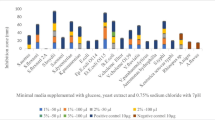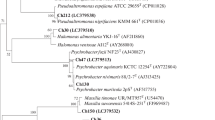Abstract
We have examined the ability of marine Proteobacteria from the Pseudoalteromonas genus and Alteromonas macleodii to produce low-molecular-weight, biologically active compounds with antimicrobial and surface-active properties. A new marine bacterium, Pseudoalteromonas issachenkonii, exhibited a high level of biological activity and produced antifungal and hemolytic compounds. A detailed spectroscopic investigation based on UV, IR, high-resolution mass spectrometry, and 2D 1H and 13C nuclear magnetic resonance revealed that the former was indole-2,3-dione (isatin). The chemical structure of red-brown pigment (C9H7N3OS3) responsible for hemolytic activity remained unclear. Four of the 15 strains studied (P. luteoviolacea, P. rubra, P. undina, and P. issachenkonii) produced cell-bound, two (P. elaykovii and P. carrageenovora) produced extracellular, and one strain (P. citrea) produced cell-bound and extracellular fatty acids and phospholipids with surface activity. Neither peptides nor glycolipids with surface activity were detected.
Similar content being viewed by others
Author information
Authors and Affiliations
Rights and permissions
About this article
Cite this article
Kalinovskaya, ., Ivanova, ., Alexeeva, . et al. Low-Molecular-Weight, Biologically Active Compounds from Marine Pseudoalteromonas Species. Curr Microbiol 48, 441–446 (2004). https://doi.org/10.1007/s00284-003-4240-0
Issue Date:
DOI: https://doi.org/10.1007/s00284-003-4240-0




